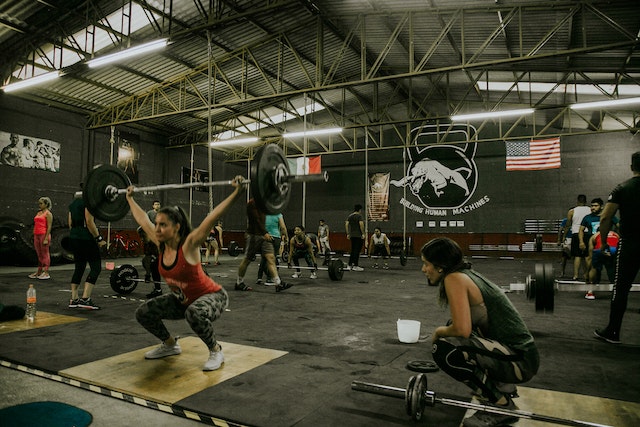Powerlifting, a strength sport that has gained immense popularity recently, is more than just lifting heavy weights. It’s a display of sheer strength, technique, and mental fortitude. Jessica Pfund delves into the fundamental elements of powerlifting, breaking down the sport’s essential components in easy-to-understand terms.
The Powerlifting Trio: Squat, Bench Press, And Deadlift
At the heart of powerlifting are three main lifts: the squat, bench press, and deadlift. These lifts test different aspects of strength and require a precise form to excel. Let’s take a closer look at each lift.
Squat
The squat is the foundation of powerlifting, targeting the muscles of the lower body, primarily the quadriceps, hamstrings, and glutes. In this lift, the lifter places a loaded barbell across their shoulders, rests it on their upper back, and bends their knees and hips to lower themselves down. Maintaining an upright torso and proper depth (where the hips go below the knees) is crucial. The lifter then pushes through their heels to stand back up.
Bench Press
The bench press focuses on upper body strength, particularly the chest, shoulders, and triceps. Here, the lifter lies on a bench and lifts a barbell loaded with weights. The barbell is lowered to the chest and then pushed back up to full arm extension. Proper grip width, arching the back, and maintaining tension throughout the body are key components for a successful bench press.
Deadlift
The deadlift tests overall body strength, emphasizing the muscles of the back, glutes, and hamstrings. To perform a deadlift, the lifter approaches a loaded barbell on the ground, bends at the hips and knees, and grips the bar. With a straight back, they lift the bar by extending their hips and knees simultaneously. The bar is lifted until the lifter stands upright with their shoulders pulled back.
The Strength Of Technique
While powerlifting is undeniably about lifting heavy weights, technique plays an equally vital role. Proper form prevents injuries and allows lifters to lift more weight efficiently. Let’s explore the importance of technique in each lift.
Squat Technique
For the stance, the lifter’s feet should be shoulder-width apart or slightly wider, with toes pointed slightly outward. The bar should rest across the upper back and shoulders, not the neck. Hitting proper depth is also crucial, and the hips should go below the knees at the bottom of the squat. Keeping the chest up and the back straight helps maintain balance and prevents rounding.
Bench Press Technique
The lifter should lie flat on the bench, with their eyes aligned under the barbell. Feet are usually placed flat on the ground. Grips can vary, but a common grip width is slightly wider than shoulder width apart. Creating a slight arch in the lower back helps reduce the range of motion and provides stability. The elbows should be tucked from the body at about a 45-degree angle during the descent.
Deadlift Technique
The feet are usually hip-width apart, and the lifter stands close to the barbell with shins almost touching it. Lifters can use both overhand and underhand grips (mixed grip) for better grip strength. Keeping a straight back is crucial to avoid rounding and potential injuries. Hips should start high, and the lifter should engage their core and leg muscles as they lift the barbell.

Mental Fortitude And Preparation
Powerlifting is not just a physical challenge; it’s a mental one too. Lifters must mentally prepare themselves to handle the weight and perform their best. Here are some mental aspects to consider.
Believing in one’s abilities is essential. Visualizing successful lifts and confidence in the training can significantly impact performance. Focusing on the task and blocking distractions is crucial during a lift. A lapse in concentration can lead to technical errors and missed lifts.
Lifters must also be prepared for unforeseen circumstances, such as changes in the competition schedule or equipment issues. Being adaptable reduces stress and allows for better performance under pressure. Not every lift will be successful, and setbacks are a part of the sport. Developing resilience helps lifters bounce back from failures and continue striving for improvement.
The Role Of Nutrition And Recovery
Powerlifting demands a lot from the body. Proper nutrition and recovery are essential for sustained progress. Here’s how nutrition and recovery fit into the powerlifting equation.
Nutrition
Powerlifters often need to consume a surplus of calories to fuel their intense training sessions and support muscle growth. Protein is crucial for muscle repair and growth. Powerlifters usually aim for a higher protein intake to aid recovery. A balance of carbohydrates, proteins, and fats provides the energy needed for training and recovery. Staying hydrated is also vital for maintaining performance and helping muscle recovery.
Recovery
Quality sleep is when the body repairs and builds muscles. Aim for 7-9 hours of sleep each night. Additionally, scheduled rest days allow the body to recover from intense training, reducing the risk of overuse injuries.
You can do foam rolling and stretching, which help alleviate muscle soreness and improve flexibility. Light activities like walking or gentle swimming are great options for active recovery. They can enhance blood flow and aid recovery.
Conclusion
Powerlifting is a fascinating sport that combines physical prowess, technical skill, mental resilience, and a supportive community. Jessica Pfund believes understanding the fundamental elements of powerlifting, from the three main lifts to proper technique, mental preparation, and the role of nutrition and recovery, provides a comprehensive view of what it takes to excel in this challenging yet rewarding endeavor. Whether you’re a seasoned lifter or someone interested in exploring the world of strength sports, the anatomy of powerlifting offers valuable insights into a sport that celebrates strength in all its forms.



